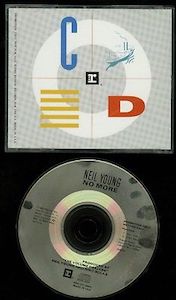
Tonight's the Night is the sixth studio album by Canadian / American musician Neil Young, released in June 1975 on Reprise Records. It was recorded in August–September 1973, mostly on August 26, but its release was delayed for two years. It peaked at No. 25 on the Billboard 200. In 2003, the album was ranked number 331 on Rolling Stone magazine's list of the 500 greatest albums of all time; it was ranked 330th in the list's 2012 edition.

Rust Never Sleeps is a live album by Canadian / American singer-songwriter Neil Young and American band Crazy Horse. It was released on June 22, 1979, by Reprise Records. Most of the album was recorded live, then overdubbed in the studio. Young used the phrase "rust never sleeps" as a concept for his tour with Crazy Horse to avoid artistic complacency and try more progressive, theatrical approaches to performing live.
"Sedan Delivery" is a song written by Neil Young that was first released on his 1979 album with Crazy Horse, Rust Never Sleeps.
"Danger Bird" is a song written by Neil Young. It was first released on his 1975 album with Crazy Horse, Zuma. A live version was also released on the 1997 album Year of the Horse.
"Out on the Weekend" is a song written by Neil Young that was the opening song of his 1972 album Harvest.
"Cowgirl in the Sand" is a song written by Neil Young and first released on his 1969 album Everybody Knows This Is Nowhere. Young has included live versions of the song on several albums and on the Crosby, Stills, Nash and Young album 4 Way Street. It has also been covered by The Byrds on their self-titled album. Like three other songs from Everybody Knows This Is Nowhere, "Cinnamon Girl", "Down by the River" and the title track, Young wrote "Cowgirl in the Sand" while he was suffering from the flu with a high fever at his home in Topanga, California.
"A Man Needs a Maid" is a song written by Neil Young that was first released on his 1972 album Harvest. It is one of two songs on Harvest on which Young is accompanied by the London Symphony Orchestra. It has appeared on several of Young's live and compilation albums.
"Powderfinger" is a song written by Neil Young, first released on his 1979 album Rust Never Sleeps. It subsequently appeared on several of Young's live recordings. A 2014 Rolling Stone special issue on Young ranked it as Young's best song ever.

"Are You Ready for the Country?" is a song written by Neil Young and released on his 1972 Harvest album. The track features Young on piano backed by the studio band dubbed The Stray Gators, comprising Jack Nitzsche on slide guitar, Ben Keith on pedal steel guitar, Tim Drummond on bass, and Kenny Buttrey on drums. Backing vocals on the track are by David Crosby and Graham Nash. The recording was made in a studio set up in a barn on Young's ranch.
"Pocahontas" is a song written by Neil Young that was first released on his 1979 album Rust Never Sleeps. It has also been covered by Johnny Cash, Everclear, Emily Loizeau, Crash Vegas, Gillian Welch, Trampled By Turtles, and Ian McNabb.

"No More" is a song written by Neil Young that was first released on his 1989 album Freedom. Although not released commercially as a single, it reached #7 on the Billboard Mainstream Rock chart. Young performed the song live on a Saturday Night Live performance on September 30, 1989.
"Scandinavian Skies" is a song written by Billy Joel that was first released on his 1982 album The Nylon Curtain. Commentators have noted its Beatle-esque elements and obscure lyrics. Joel has stated that the song was inspired by an experience with heroin. Although not released as a single, it reached #38 on Billboard's Mainstream Rock chart.
"The Old Laughing Lady" is a song written by Neil Young that was first released on his 1968 debut solo album Neil Young.
"Harvest" is a song written by Neil Young that was the title song of his 1972 album Harvest.
"From Hank to Hendrix" is a song written by Neil Young that was first released on his 1992 album Harvest Moon. Young has frequently included it in live sets and it has been included on a number of live and compilation albums.
"Unknown Legend" is a song written by Neil Young that was first released on his 1992 album Harvest Moon. Although it was not released as a single, it reached #38 on the Billboard Magazine Mainstream Rock Tracks chart.
"I Believe in You" is a song written by Neil Young that was first released on his 1970 album After the Gold Rush. It has also been covered by other artists, including Linda Ronstadt, Robin Zander and Rita Coolidge. Coolidge's version was released as a single and was a minor hit in Canada.
"Crime in the City " is a song written by Neil Young that was first released on his 1989 album Freedom, although Young had performed longer versions in concert earlier. It was not released as a single but reached number 34 on the Billboard Magazine Mainstream Rock Tracks chart. It is a lengthy song, with a released version of almost nine minutes, but earlier versions were more than twice as long. It has been characterized as a document of moral rot in urban regions of the United States in the late 1980s.

"Everybody Knows This Is Nowhere" is a song written by Neil Young that was originally released as the title track of his 1969 album with Crazy Horse, Everybody Knows This Is Nowhere. The song was written earlier, and a different version was originally considered for Young's 1968 solo debut album Neil Young
"Country Girl" is a song written by Neil Young that was first released on Crosby, Stills, Nash & Young's 1970 album Déjà Vu.





